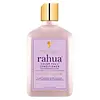What's inside
What's inside
 Key Ingredients
Key Ingredients

 Benefits
Benefits

 Concerns
Concerns

 Ingredients Side-by-side
Ingredients Side-by-side

Water
Skin ConditioningAloe Barbadensis Leaf Extract
EmollientHibiscus Sabdariffa Flower Extract
Skin ConditioningEclipta Prostrata Extract
Skin ConditioningVaccinium Myrtillus Fruit Extract
Skin ConditioningBehentrimonium Methosulfate
Helianthus Annuus Seed Oil
EmollientCetearyl Alcohol
EmollientOenocarpus Bataua Seed Oil
EmollientButyrospermum Parkii Butter
Skin ConditioningGlycerin
HumectantKaolin
AbrasiveZinc Oxide
Cosmetic ColorantHydrolyzed Quinoa
Skin ConditioningStearalkonium Chloride
PreservativeGardenia Jasminoides Callus Culture
AntioxidantAroma
Cyamopsis Tetragonoloba Gum
Emulsion StabilisingOcimum Basilicum Extract
AntioxidantMauritia Flexuosa Fruit Oil
Skin ConditioningMoringa Oleifera Seed Oil
EmollientLinum Usitatissimum Seed Oil
PerfumingRose Extract
Skin ConditioningVaccinium Macrocarpon Seed Oil
Skin ConditioningWater, Aloe Barbadensis Leaf Extract, Hibiscus Sabdariffa Flower Extract, Eclipta Prostrata Extract, Vaccinium Myrtillus Fruit Extract, Behentrimonium Methosulfate, Helianthus Annuus Seed Oil, Cetearyl Alcohol, Oenocarpus Bataua Seed Oil, Butyrospermum Parkii Butter, Glycerin, Kaolin, Zinc Oxide, Hydrolyzed Quinoa, Stearalkonium Chloride, Gardenia Jasminoides Callus Culture, Aroma, Cyamopsis Tetragonoloba Gum, Ocimum Basilicum Extract, Mauritia Flexuosa Fruit Oil, Moringa Oleifera Seed Oil, Linum Usitatissimum Seed Oil, Rose Extract, Vaccinium Macrocarpon Seed Oil
Water
Skin ConditioningAloe Barbadensis Leaf Extract
EmollientCamellia Sinensis Leaf Extract
AntimicrobialRosmarinus Officinalis Leaf Extract
AntimicrobialRubus Idaeus Leaf Extract
Skin ConditioningSodium C16 Olefin Sulfonate
EmulsifyingCoco-Betaine
CleansingSodium Chloride
MaskingGlycerin
HumectantSaccharum Officinarum Extract
MoisturisingGlycine
BufferingOenocarpus Bataua Seed Oil
EmollientBursera Graveolens Wood Oil
MaskingHydrolyzed Quinoa
Skin ConditioningPanthenol
Skin ConditioningPotassium Sorbate
PreservativeCaprylic Acid
CleansingCitric Acid
BufferingWater, Aloe Barbadensis Leaf Extract, Camellia Sinensis Leaf Extract, Rosmarinus Officinalis Leaf Extract, Rubus Idaeus Leaf Extract, Sodium C16 Olefin Sulfonate, Coco-Betaine, Sodium Chloride, Glycerin, Saccharum Officinarum Extract, Glycine, Oenocarpus Bataua Seed Oil, Bursera Graveolens Wood Oil, Hydrolyzed Quinoa, Panthenol, Potassium Sorbate, Caprylic Acid, Citric Acid
Ingredients Explained
These ingredients are found in both products.
Ingredients higher up in an ingredient list are typically present in a larger amount.
Aloe Barbadensis Leaf Extract is an extract of the leaves of the aloe, Aloe barbadensis, Liliaceae.
Aloe is one of the most well-known natural soothing ingredients, and for good reason. It’s full of water and has a cooling, calming effect on the skin, especially when it’s sunburned, itchy, or irritated. Aloe also helps your skin stay hydrated and smooth by mimicking what healthy skin naturally produces. On top of that, it contains vitamins and nutrients that support skin recovery.
It doesn’t protect you from the sun, but it can help your skin bounce back after too much time in it.
Let’s get into the details:
Aloe contains antioxidant Vitamins A, C, and E, which help fight off free radicals (unstable molecules from things like pollution that can damage your skin).
It’s also rich in polysaccharides, which are natural sugars that help hydrate the skin by acting like the skin’s own moisturizing agents. These, along with other sugars like monosaccharides, help form a protective barrier that locks in moisture.
Aloe works as both a humectant and an emollient. That means it draws water into the skin (humectant) and helps trap it there (emollient), making it an effective natural moisturizer.
You’ll also find a mix of other skin-supporting ingredients in aloe, including folic acid, choline, calcium, amino acids, fatty acids, and even Vitamin B12.
Out of the 420+ species of aloe, Aloe barbadensis is the most widely used in skincare products thanks to its gentle yet effective properties.
There are over 420 species of aloe but Aloe Barbadensis is the most commonly used for topical products.
Learn more about Aloe Barbadensis Leaf ExtractGlycerin is already naturally found in your skin. It helps moisturize and protect your skin.
A study from 2016 found glycerin to be more effective as a humectant than AHAs and hyaluronic acid.
As a humectant, it helps the skin stay hydrated by pulling moisture to your skin. The low molecular weight of glycerin allows it to pull moisture into the deeper layers of your skin.
Hydrated skin improves your skin barrier; Your skin barrier helps protect against irritants and bacteria.
Glycerin has also been found to have antimicrobial and antiviral properties. Due to these properties, glycerin is often used in wound and burn treatments.
In cosmetics, glycerin is usually derived from plants such as soybean or palm. However, it can also be sourced from animals, such as tallow or animal fat.
This ingredient is organic, colorless, odorless, and non-toxic.
Glycerin is the name for this ingredient in American English. British English uses Glycerol/Glycerine.
Learn more about GlycerinWe don't have a description for Hydrolyzed Quinoa yet.
Oenocarpus Bataua Seed Oil is an oil.
Water. It's the most common cosmetic ingredient of all. You'll usually see it at the top of ingredient lists, meaning that it makes up the largest part of the product.
So why is it so popular? Water most often acts as a solvent - this means that it helps dissolve other ingredients into the formulation.
You'll also recognize water as that liquid we all need to stay alive. If you see this, drink a glass of water. Stay hydrated!
Learn more about Water